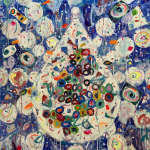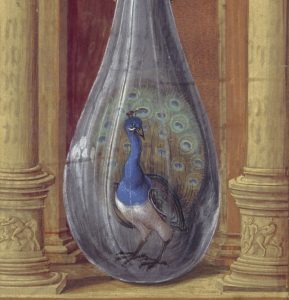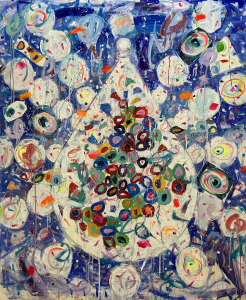
The alchemical Peacock’s Tail arises from the blackened material of the five stages of the nigredo. The nigredo, or blackening stage, works on our fears and insecurities. It forces us to become more introspective about our personality and desires—the parts of us that feel lacking or undeserving.
For the spiritual alchemists, the blackening was the meditator’s initial encounter with the dark inner world as consciousness leaves the physical body and the senses. This was often symbolized by the Black Crow or Raven as mediators between the physical and spiritual worlds. [1] The Peacock’s Tail signifies the awakening of kundalini and passing through the initial dark void and experiencing the multi-colored patterns and iridescence of the astral realm. Thus, we have a picture of alchemy as both a physical process and a soul process. [2]
The process leading to the Peacock’s Tail relies on the fourth operation of Conjunction. Conjunction combines what remains of value from the blackened elements of the previous three stages. Essentially, it draws together and harmonizes any leftover polarized or conflicting aspects of our personality, such as male intellect and logic with female intuition and emotion. [3]
The product of Conjunction is given a new life in Putrefaction followed by Fermentation. The goal is to change its characteristics, to completely raise it to a whole new level of being. The Emerald Tablet tells us to leave the earthly realm by the fire of imagination, “gently and with great Ingenuity,” into a state that sets our soul afire with higher passion. [4]
The process of Putrefaction includes a period where the ego of our former self is allowed to rot and decompose and let go. It can be a difficult period as strong feelings of depression or despair may be involved as we struggle to cope with losing our past personality identifiers. The second stage of Fermentation (spiritualization) brings us back to a new life in spirit, like how grape juice changes its identity into a newborn wine that contains a higher and more active life-energy. The end of Putrefaction and the beginning of Fermentation is marked by the appearance of a yellowish white layer of digesting bacteria and an oily film the alchemists named the Cauda Pavonis (“Peacock’s Tail”).

Personal Fermentation is the art of actively living an inspired life through a renewed connection with the inner world and the Divine. This can be achieved through mystical awareness, intense prayer, and other activities that include the breakdown of the personality, transpersonal therapy, and/or deep meditation. [5]
The arrival of the Peacock’s Tail marks a turning point in the journey of the hero. Up to this point, the alchemist has been working on their mental and emotional bodies. The Peacock’s Tail marks the end of the blackening and the beginning of the whitening or albedo stage. The practitioner has now reached the hero’s stage of Accepting the Call. This is the stage of individuation, where the hero has sublimated their personality/ego-self into a realized, and authentic self. This is the self-aware self that takes responsibility for their conditioned ways of thinking, their narrow belief systems, and how they interact with themselves and others. The appearance of the Peacock’s Tail is considered a transitory stage leading to the next phase of the whitening, which has to do with the work of our inner being.
- “The Birds in Alchemy” by Adam McLean, first published in the Hermetic Journal No. 5., 1979. alchemywebsite.com/alcbirds.html
- “A Commentary on the Rosarium Philosophorum” by Adam McLean, originally published in Magnum Opus edition the Rosary of the Philosophers, Edinburgh, 1980. alchemywebsite.com/roscom.html
- “The Seven Stages of Spiritual Alchemy and What They Mean” by Thomas Ellison, Aug 12, 2021. thecollector.com/spiritual-alchemy-occult/
- “The Azoth Ritual” by Dennis William Hauck. azothalchemy.org/azoth_ritual.htm
- Ibid.


